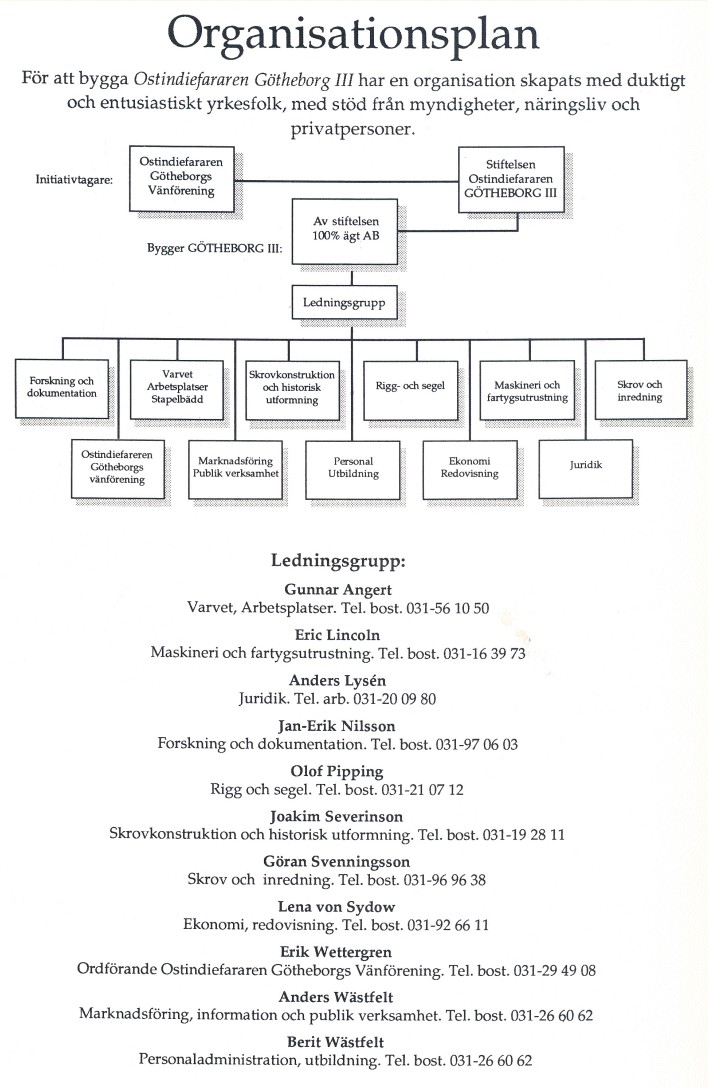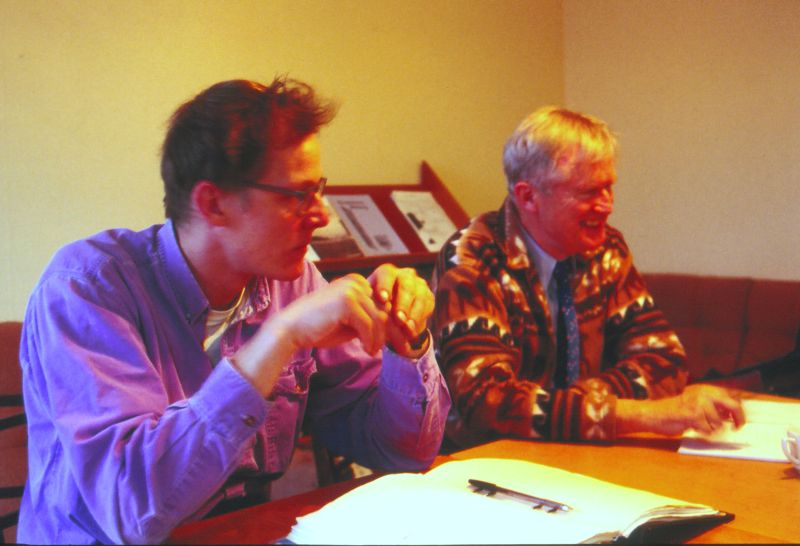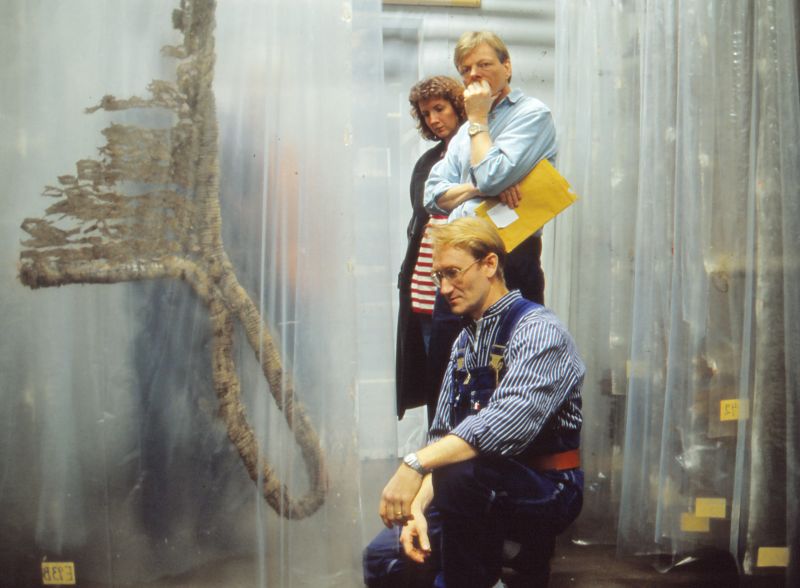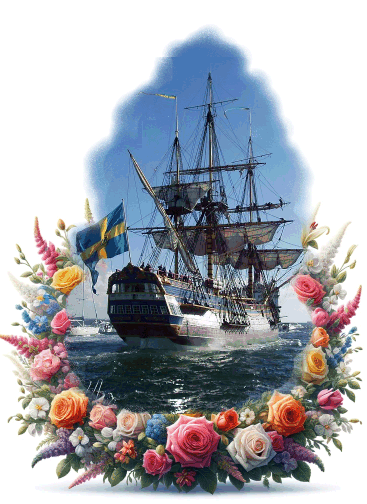
During this first formative stage of the project 1990-1992, when ideas were being generated and explored, I would say that hundreds of people were involved, offering their creative thinking and a free flow of ideas, without immediate concern for feasibility or practicality. The goal during this phase was to generate a wide range of possibilities and options, which could be refined and evaluated in later stages of the project. At this stage, Anders was exploring what resources could be brought to bear, while Berit's work in evaluating people resulted in the forming of the 'Management Group'. This plan and executive core group eventually started to meet every week at Skateberg in Hisingen to set in motion the project of building a sailing Swedish East Indiaman based on the Gotheborg ship, and with this, make a new trip to China and back.
The organization was fundamentally a 'process' type with almost no hierarchy. Missing in this first Organisational Chart of 1993 here are many individuals who joined the project later, as well as all those involved in building the hull, sail making, rigging, and our blacksmith, Berth Johansson, and his team. A complete list of everyone who dedicated years of their life to this project would include several thousand names. Regrettably, no such comprehensive list exists, but in all fairness, there should have been one to acknowledge the contributions of all who helped and were involved in the project.
Together, we knew that this project was feasible. There were just a few challenges to address: creating an organization, finding a location for a shipyard, identifying a builder for the ship, and figuring out the financing.
In October 1992 the idea of building a replica is presented by Anders Wästfelt to the Friends of the Gotheborg Organization. The 'Friends' fully embraces the vision. Money is advanced towards the funding of a feasibility plan for the new project. An organizing committee is brought together to make the project a reality. Berit Wästfelt has the last say in who is going to be in or out. The original members came to be Anders Wästfelt - the sole individual initiator - as (Information and Marketing) and his wife, Berit Wästfelt for (Recruitment and Staff Administration). In the committee is also Erik Wettergren (Chairman) and later first CEO, Lena von Sydow (Economy). Jan-Erik Nilsson (Research and Documentation, later also IT), Erik Pipping (Historical Rigging), Eric Lincoln (Nautical Engineering) and Joakim Severinsson (Ship's Construction). Soon several more people are added to this first committee that eventually, together with Bo Alfredsson, second CEO after Erik Wettergren, becomes the Management Group who are also the only ones doing any real management of the project until the hull is well under way to be built, in mid 1997.
For anyone aspiring to undertake a similar venture, the technique of managing such a project is straightforward. Define the start and end points, break up the journey into small steps, and then get going, one step at a time.

This is a page from the first formal presentation brochure I created for the project, the 'Invitation to Sponsors' brochure from February 1994.
This is at a very early stage and the various ship building groups are just shown as blocks.
At this time the only legal entity that had any interest in this project except ourself as private persons was the Friends of the East Indiaman Gotheborg Organization. With Erik Wettergren, the well reputed owner of the Wettergrens book stores as a Chairman and Berit Wästfelt as secretary, the 'Friends' enthusiastically turned their support towards the new purpose and also decide to fund a feasibility plan and the drafting of the future organization.
Next was to try to find a number of key specialists that would be willing to volunteer their expertise and become the core Management Group. The members would individually be responsible for each their own part of the project. They would need to do this for free as long as it was needed without any compensation except that they would be allowed to be in the project when and if it could be brought to bear, and that would only depend on ourself. In this Berit Wästfelts expertise as a former HR manager was put into good use. Her judgment was the sharpest I have ever seen.

This is mid February, in the winter, 1993. From left to right, Eric Lincoln (ship's systems) and Gunnar Angert (shipyard planning).
Meeting at Skateberg which were our first meeting place before the building of the Shipyard Terra Nova. At this meeting Anders Wästfelt tells that he has met with Bengt Tengroth at Eriksbergs Förvaltnings AB and secured a promise to use a part of the old Eriksberg Shipyard for our project. Now we had found the location for the shipyard.
The original members of the Management Group volunteered to make the early and crucially important contributions to the project.
Some just turned up, like for example Gunnar Angert who walked up to us at the yearly Maritime Exhibition at Svenska Mässan and presented himself. He had a history at Eriksbergs shipyard when it was an important part of the Swedish Shipbuilding industry, and together with Anders Wästfelt drew up the plan for the Terra Nova Shipyard.
Erik Lincoln, was at the time studying Ships Engineering at Chalmers and created the first plan on how the Ships technical systems could be fitted into an 18th century hull while still being up to acceptable modern standard.
During the winter of 1992/93 we had set up an exhibition at the Maritime Museum in Stockholm and Anders also went there to give a lecture. At that time we also visited the Vasa museum. Partly because it was interesting to see a wooden ship of roughly the size of what we had in mind, but also to see what information we could gather on the subject of historic ship's building from this ship.

Olof Pipping was at this this time employed by the Vasa Museum to reconstruct the rigging of the Vasa. Behind him, Björn Ahlander, our most crucially needed rigging expert. To give us an idea of what we were up to, Olof showed us a parts of the original sails found on board the Vasa. Vasa was however more then 100 years older than the Gotheborg, was intended as a warship and, did not really work out all that well, so the differences compared to what we wanted to accomplish were significant. Photo: Jan-Erik Nilsson, The Vasa Museum, Stockholm 1992.
Olof Pipping volunteered as our expert in Historic Rigging and drew up the general rigging assemblage.
Göran Svenningson would work with the ship's Interior Design.
Lena von Sydow had been taking care of the book keeping for the previous excavation project was would continue this work here.
Erik Wettergren, was Chairman of the 'Friends of the Gotheborg' Organization and would also function as the Chairman in our management group.
Anders Wästfelt, the ultimate initiator would concentrate on Marketing of the project and organize the sponsorship reward programs and public activities.
Berit Wästfelt, formerly HR manager at the Gothenburg Östra Hospital was a given for HR administration here too. She was a contributing co-founder together with Anders and his better half as well as sounding board. She ran the Friends Organization with her left eye and was the sharp eyed talent hunter for the shipyard, with the other.
Jan-Erik Nilsson, myself, which role as Anders' confidant and business partner in our exhibitions, was not that clear. I participated in practice as the professional marketing and business consultant I was, as the head of MarknadsGruppen, a business consulting group I had started immediately after my Business School studies at former HHG. As an amateur historian, specializing in the Swedish East India Company I doubled as responsible for historic authenticity and conceptualization of the values we would create.I also became the project's IT guru as my awareness of the new Internet grew and I realized its potential for future trade and communication. I envisioned how our ship in the future would work as a flagship for a future business empire on the Internet.
Bert Johnsson, the blacksmith who built his own Smedja Volund directly on the shipyard area. Without his hand-welding of thousands of iron details, not available in any other way, we would have been completely stuck. I still remember how he approached us the first time and said, 'You might think that your ship, that you want to build, is mostly wood, but you will not believe how much iron will go into it. And every single piece will need to be hand welded. You can't go into any shop and buy anything of what you need. None of it is available in the shops anymore.' He was very right. I remember how my heart sank when hearing him saying this, but then he presented himself as a blacksmith with a plan ...
Björn Ahlander, our eventually most crucially needed rigging expert. What he together with his colleagues would do in recreating the rigging of the East Indiaman Gotheborg so that it not only looked right, but was also possible to safely sail and navigate with was nothing short of a miracle. Well, so was a lot of other things too but looking at the rig, that is a piece of art.
'Café Nova', run by Eva Carlsson, the favorite caterer from the excavation would also follow to the new project.
A complete list of all individuals who contributed significant portions of their lives to this project would include several thousand names.
The 5 November 1993 we were done with the planning and had put together all documents with consistent project objectives and prepared all formalities to get on with the next step in setting up the formal structure of the project. We needed a clear non-profit owner to which we could direct all funds and donations and we needed a formal corporation where you could hire staff and actually build the ship.
To this end we created The East Indiaman Götheborg III Foundation to assume the overall responsibility for the project and to become the beneficiary of the donations that would be needed to fund the project.
All members of the Friends organization and all former sponsors were invited to become Founding Fathers and to resume the sole responsibility to oversee the activities of the foundation, and to that end to have the right to select the members of the Board of Directors of this Foundation, every year, at an annual meeting.
More than 40 friends and sponsors showed up and signed the founding papers, and at the same time elected the first Board of Directors.
This original group of Forty Founding Fathers who at this time put their names on the foundation documents were from now on to be called The Founders of the project. This group of about forty persons were also the ones that would have the final say and deciding power on how the project were to be run through their power to select the Board of Directors of the Foundation on a yearly meeting.
Immediately following the founding meeting we went ahead with creating the company that were to build the ship. After having set up the Board of Directors to the company too, we went ahead and registered it. As luck would have it the old Swedish East India Company SOIC AB was available why this became the obvious choice of names. As for persons to man the Boards of both the Foundation and the Company, we had looked for the most well connected and respected names we could find, willing to join in on this project.
The 28 December 1993 the Friends donated the funds necessary for us to register the The Swedish East India Company AB as a fully owned company to build the ship. We then donated these 100 percent of the shares of the SOIC AB to the Foundation that so far did not have any other capital.
We had now created what we felt was a good organization for a non-profit project that would be solid and also be able to handle substantial amounts of money. In the purpose document of the various bodies were clearly stated their various purpose. The ultimate power rested with the Forty Founding Fathers in that they would be there to select who were going to be in the Board of Directors of the Foundation, once every year.
The purpose of the Foundation was to put it bluntly, to organize the money and to sign sponsorship contracts. This body would then support the company SOIC AB in their work to build the boat. The SOIC AB were then supposed to hire the Management Group to run the project as soon as there were any money available for that.
The Friends organization would support the project directly by help and donations if and when needed.
As for workers and some staff, Berit had got an arrangement with the Regional Board of Labour (Länsarbetsnämnden) that we could sign up and use a certain number of people that could work for us but got paid by the Regional Board of Labour. In this arrangement there were however no resources left for the managing of anything, why Berit herself was left out of pay.
What we had not been able to foresee was that there would be no money available for the Management Group until December 1998. The reason for this was simple, that there is no way to find sponsors for a ship that does not exist, and the number of visitors that would like to pay to see an empty spot where a shipyard should be is also very limited. If there were ever to be any money in this project is was up to us who started it, to make that happen.
Erik Wettergren was the first of the Gothenburg profiles who dared to volunteer as the first CEO of our newly established Swedish East India Company AB. I would say that it was his firm personal conviction combined with his solid reputation as a serious and competent Gothenburg businessman that made many of our early supporters trust that this could actually be done.
In early 1995 Bo Alfredsson step up to become the second CEO of our new company and by securing some larger sponsors lead it to some firmer ground.
In 1996 the heavy industry steps in and the former shipyard manager Erkki Persson took over the leadership of the ship building part of the project. He also added professional knowledge in how to have a ship approved and classed for sailing.
Beginning in 1996, the project's focus shifted. Leadership and management increasingly transitioned to experienced people from the industry. Spearheading this change was the former head of Eriksberg Shipyard AB, and later Svenska Varv, Bengt Tengroth. He had not only provided the land for our East Indiaman project but also via Norra Älvstrandens Förvaltninga AB played a key role in organizing the funding needed to bring the project to fruition. While becoming the Chairman of SOIC AB, the company we had created to construct the ship and shipyard, he early on recognized the project's potential.
Much of the early attention the project received in Asia can be attributed to the substantial efforts of Bengt Johansson, who was with the Swedish Ministry of Foreign Affairs and later became the Swedish Consul General in Shanghai, and Anita Johnson from the Swedish Trade Council. They played a pivotal role in organizing a series of exhibitions in Singapore, Hong Kong, and Shanghai about the excavation results, laying the groundwork internationally. Their invaluable assistance not only facilitated a splendid reception in Canton but also aided hundreds, if not thousands, of Swedish companies in establishing a presence in China as a result of our project.
The enthusiasm and assistance given by the former Professor of History, Jörgen Weibull and Professor Bo Gyllensvärd, regarding the Swedish interest of Chinese culture throughout the history as well as regarding the Chinese porcelain cargo of the original Gotheborg, was extremely important.
Among all this one special thought would need to go to the local newspaper GP whose unending support from the excavation phase and onwards by giving the project a public voice was critically important, and to Volvo AB to whom I personally wrote the first letter of information by the end of 1993 and still in my archive, starting with "Dear Sir, I have the pleasure of informing you of the upcoming project of building a full scale sailing replica of the East Indiaman Gotheborg which foundered and sank just outside the harbor of Gothenburg the 12th of September 1745… ".
Our optimism was rewarded by an unending support that soon granted us the use of two Volvo cars for necessary transportations and the promise that they would supply the ship with two Marine Engines, once it was built.
Many important individuals also very early lent their names to the different Boards of the project. One of these were the then current Province Governor, Landshövding Kjell A. Mattsson, who took on the Chairmanship in the Foundation we had registered to be the main and central owner of the entire project.
Still as always, nothing would have happened without the help of hundreds of volunteers were they divers, amateur archaeologists, archive researchers, tidying up the shipyard area, made sandwiches or maybe just gave us a smile when all were tired. The gratitude that should be granted to all and everybody involved in this visionary and exciting project is immense. I have here only been able to mention a fraction of those I personally know have contributed their support. It is my hope that in time all and everybody's efforts will be properly recognized.

Thank you all!